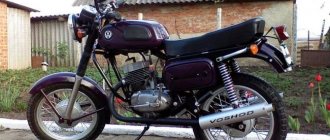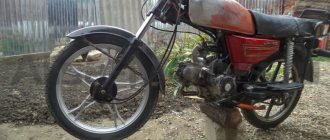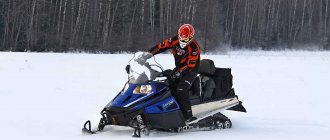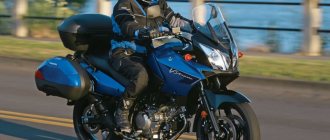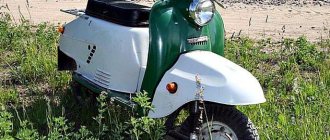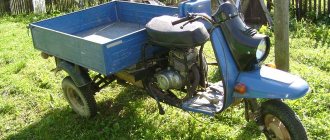The Barkhan tricycle is the brainchild of one of the oldest Russian enterprises - the V. A. Degtyarev plant (ZiD), located in the city of Kovrov. In general, since its founding (and this is 1916), the plant has specialized in the production of defense products, but also produces civilian equipment, including motorcycles and special equipment.
Back in 2002, ZiD designers came up with the idea of creating an all-terrain vehicle that would be used to transport people and cargo in varying degrees of off-road conditions, mainly over rough, swampy and snowy terrain.
general description
The Barkhan all-terrain vehicle is based on the Sova off-road vehicle. It is equipped with a two-stroke power unit with forced atmospheric cooling. The engine capacity is 200 cubic centimeters and is started using a kickstarter. Karakat is equipped with lights and luggage racks, which allows it to be used on public roads. The device is perfect for tourists, fishermen, hunters and geologists.
The designers of the all-terrain vehicle used a win-win formula - they combined large wheels and low weight of the equipment. In addition, several innovative solutions have been added. The three-wheeled all-terrain vehicle is equipped with low-pressure tires, an enlarged fork and an upgraded engine. The result was a tricycle with impressive parameters, which quickly and successfully occupied a niche among its competitors.
The cheapest all-terrain vehicle. Karakat ZIS-5
2019 Photos by [Darkaim] from Review Machines
Looking at the all-terrain vehicle-tricycle Barkhan, one might think that this is the cheapest all-terrain vehicle. But no! It turns out there are even cheaper options.
Introducing the Vologda vehicle ZIS-5
Its cost in 2022 is only 130,000 rubles. How was it possible to achieve such a minimum price for a four-wheeled all-terrain vehicle with all drive axles? Let's take it apart "piece by piece" and everything will become clear.
The design is a classic “fracture”, as they are also called “karakat”. Read more about fractures in a separate article.
The frame is welded, made of a square profile, consists of two parts, which are connected to each other by a hinge mechanism made from a UAZ steering knuckle.
The engine, already time-tested, simple and unpretentious, single-cylinder Lifan190FD with a power of 15 hp. with electric starter and lighting coil.
In the minimum configuration of the all-terrain vehicle, the engine is started manually, but you can install a battery and use an electric starter.
The wheels are classic “rugged” ones. They are made from disused rubber from heavy equipment: KAMAZ All-terrain vehicle (1220x400), URAL OI-25 (1300x370), URAL Lapot (1200x500) or KRAZ (1300x530). The tire weight is about 20 kg (from the original 80). They are used together with a tube.
Wheels of our own making. There is a special corner inside the disk that prevents the tire from “rotating.”
Gearbox from classic VAZ models
The gearbox is driven from the engine by a belt drive.
Instead of a conventional clutch, a circuit is used that weakens the tension of the drive belt.
Then, using a chain transmission (from an IZh motorcycle), the torque is transmitted to the drive axles. The chain stretches very quickly, so the gearbox mount is made in such a way that the box can be moved and the chain can be tensioned.
Bridges from classic VAZ models
The brakes are hydraulic, but only on the front wheels.
Steering is implemented using a steering rack from a VAZ-2108
Due to the volume of the wheels, the all-terrain vehicle can float.
The rear part of the all-terrain vehicle is a very impressive body. Which, if desired, can accommodate 4 people or some cargo.
The all-terrain vehicle's carrying capacity is stated to be 500 kg.
And now the most interesting thing - how did you manage to make an all-terrain vehicle so cheap? This is due to the fact that most of the spare parts are used for the second time (used ear parts). Wheels, axles, gearboxes, steering, driveshafts are all restored, practically taken from scrap metal.
Performance characteristics
The all-terrain vehicle "Barkhan" can rightfully be called a unique device by today's standards. The equipment was announced for release in 2007, but went on mass sale only in 2010. During this time, the developers have improved the design, allowing it to overcome all kinds of obstacles.
Main characteristics:
- load capacity indicator - up to 200 kilograms;
- maximum weight of towed device – 270 kg;
- maximum speed – 40 kilometers per hour;
- number of seats – two;
- net weight of transport – 0.33 tons;
- front suspension - lever type with hydraulic spring shock absorbers;
- there is no rear suspension;
- frame – welded tubular element;
- There are rear shaft supports located on the subframe.
Despite the fact that the Barkhan all-terrain vehicle is not distinguished by its high speed qualities and large load capacity, it can go where other analogues should not even try. In principle, this is what it is designed for.
History of creation
In regions with harsh climates, special transport is a real necessity. Many designers thought about how to create a car that would not only overcome the endless expanses of the tundra, but also would not harm nature. Initially, the SUV in question was developed as a snowmobile. However, in the process of work, new ideas appeared, which were successfully brought to life by designer Marinin and his colleagues.
The low-pressure tires installed on the Barkhan are friendly to the sparse vegetation of the North. Even after the tricycle passes over moss or fragile trees, they do not disappear, but after a short time resume a full-fledged life process.
Test Drive
like a regular motorcycle. Turn on the ignition and press the starter button. Just in case, there is also a kickstarter, which allows you to start the engine with your foot using a pedal. When cold, the engine is reluctant to hold speed, fortunately there is a choke that solves this problem. In terms of handling, everything here is like that of a motorcycle. The right handle is the gas, the lever under the left hand is the clutch, the lever on the right is the front brake, under the right foot is the rear brake.
The gears shift clearly, you can get used to it in just a couple of minutes, even if you have previously ridden motorcycles one and a half times in your entire life. There is a neutral gear indicator on the dashboard, and the gears themselves will have to be counted in your head. “Darkhan” starts off briskly, but the traction quickly subsides, and the engine asks to “feed” it second gear. In fifth it is comfortable to drive at a speed of 20-25 km/h. Closer to 30 km/h, the speed is too high, vibration is noticeably transmitted to the steering wheel. It is better to ride with gloves.
“Darkhan” weighs 330 kg and feels very clumsy. The specifications say that the turning radius of this all-terrain vehicle is 5 meters. A bit much even in raw numbers. In fact, maneuvering an all-terrain vehicle is even more difficult than it seems. At low speeds, the steering requires enormous effort, and if the surface is snow or ice, the front wheel slides forward even in the turned position. But with gas you can set the Barkhan sideways. Surely, with practice, you will be able to write spectacular drift sketches.
“Darkhan” drives frankly slowly, but that’s good. At high speeds, a 3-wheeled all-terrain vehicle would feel unstable and would be prone to tip over. Still, in terms of stability, the model is far from ATVs. But the Barkhan outperforms both quads and snowmobiles in terms of cross-country ability and versatility. Especially when it comes to swampy areas. The all-terrain vehicle is capable of carrying up to 150 kg of cargo and towing a trailer weighing up to 200 kg.
Among the disadvantages is that each wheel makes its own “path”, which complicates the driving process in certain conditions. If there is a difficult hole or other obstacle on the way, it is almost impossible to go around it, for example, between the wheels. After the “Darkhan” there is actually one large and continuous trail 1800 cm wide. The overall length of the machine is 3 meters. Considering the ban on movement on public roads, before purchasing an all-terrain vehicle, you need to think about how to deliver it to the place of operation, if it differs from the place where the equipment is stored. A trailer or even a regular carriage will not work for a passenger car. So before buying this toy, it won’t hurt to buy another one - for example, a cargo bead.
User manual —
Exploitation
Snow and swamp-going vehicles on Barkhan wheels can easily overcome off-road conditions. At the same time, the technique moves smoothly and without jerks. The all-terrain vehicle moves at low speed and can even swim. This option is available thanks to the presence of light and wide wheels. Of course, a tricycle will not replace a boat, but if the ice falls through, it will get out of the water slowly and confidently. Difficulties may arise when leaving a reservoir through silt. In such a situation, it is better to use reverse gear.
The vehicle behaves no less confidently on asphalt than off-road. The car smoothly overcomes all bumps, but sways slightly. The all-terrain vehicle lives up to its name, resembling a camel conquering endless desert spaces. Still, asphalt is not his element.
Peculiarities
For passengers, riding on the Barkhan cannot be called comfortable. You need to adapt to the tricycle in order to maintain your balance. The driver must correctly calculate the trajectory of all wheels, otherwise the possibility of rollover increases. The snow swamp vehicle is not designed for racing or rallying. Its main task is to overcome any off-road conditions, which it does well.
Three-wheeled all-terrain vehicles have increased ground clearance, which virtually eliminates the bottom from clinging to the surface. The equipment's tires are hard, with low tread, and easily begin to slip. However, thanks to good inertia and low weight, they quickly find contact with any surface. Cross-country ability can be enhanced by using special tapes or chains.
Possibilities
Karakat Barkhan 200 (the number indicates engine capacity) is capable of transporting two people with a load over rough terrain with natural and artificial inclines and slopes, and overcoming trenches and dumps. The compact and economical amphibious all-terrain vehicle is effective when operating on waterlogged soils - on fluid clays and loamy areas covered with a thick layer of silt or peat, more than 30 cm thick. A river or lake is not an obstacle to the all-terrain vehicle.
The amphibious three-wheeled all-terrain vehicle Barkhan confidently floats on the surface of the water due to the volume of air in the tires, thanks to the properties of which, low weight and high ground clearance, the tricycle’s high cross-country ability is achieved. In addition to the cargo secured to the rear metal trunk, the trike can tow a cargo or passenger trailer with a total weight of up to 270 kg.
Application
The Barkhan all-terrain vehicle, the price of which is quite reasonable, is an indispensable vehicle for tourists who like to visit little-explored territories. The equipment is also perfect for fishermen, hunters, extreme sports enthusiasts and residents of remote settlements.
The actual operation of a domestic tricycle cannot be called elementary. Operating the unit requires experience, confidence and ingenuity. If necessary, "Barkhan" can be improved. Most often this concerns light elements and wheels. The all-terrain vehicle in question is considered a narrow-profile vehicle that will be useful in many regions of the country.
